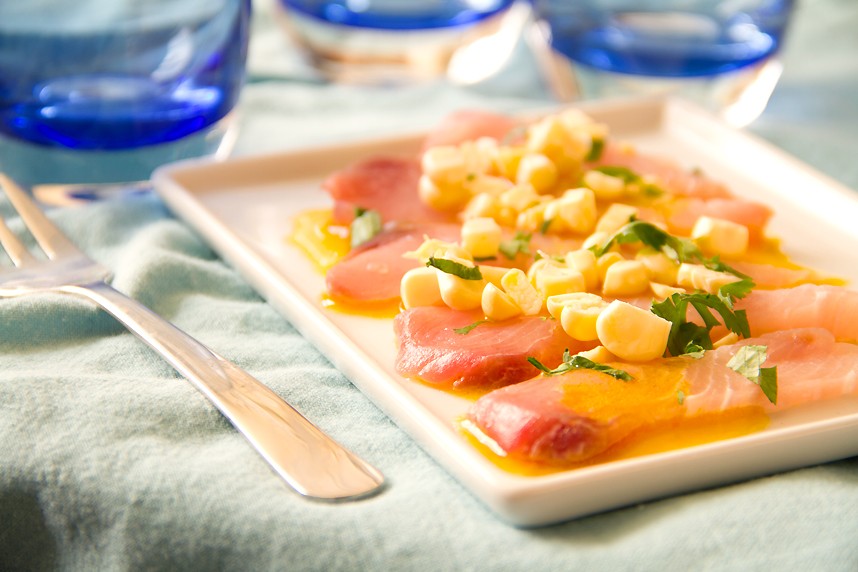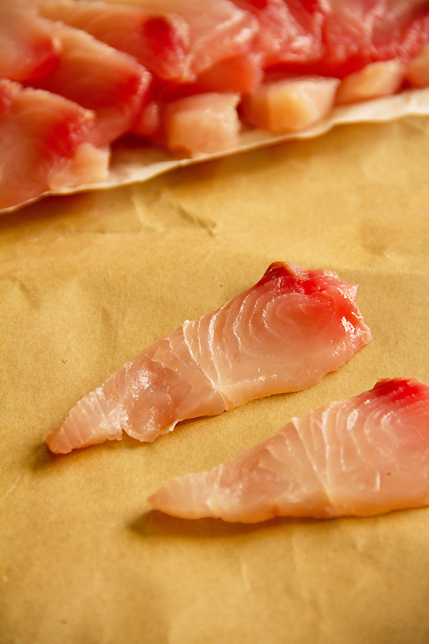
I’ve got more culinary delights to share from my recent trip to South America. The first stop we made was in Lima, Peru. The oldest parts of Lima are rich in Spanish colonial history. Architecture buffs could wander the streets in awe for days. While its connection to ancient Incan civilization will keep a visitor occupied even longer. However, I fall into the category of gastro-tourist and the new Lima is so rich gastronomically that it puts many of the world’s other great cities to shame. In fact thanks to the time I spent on Visit Peru’s, Cooking in Peru website, I came to Lima para la cocina: for the food. In the process I became a fanatic for Peruvian Tiradito.
It’s tempting to compare Tiradito to the National dish of Peru– Ceviche (where it’s known as Cebiche). Both are fresh, raw seafood dishes that have been “cooked” by citrus juice. However, Cebiche has the bold pungency of onions, and uses sweet potatoes and oversize kernels of corn (choclo) to balance the bracing marinade. Tiradito uses more subtle charms to bring the sweet, raw fish into focus.
One of the main purposes of my trip was to learn as much as I could about Peruvian cooking, then share some of that knowledge here. The first thing I learned in preparation for this trip is that Peru has a 500-year tradition of Italian, Spanish, African, Japanese and Chinese immigration mixed with the native Quechua culture. Making modern day Lima a highly creative culinary melting pot.
I also learned that most Latin cultures make some version of Cebiche. However, Peruvians claim this dish as their own and insist it was first developed in Peru. Which may explain why Peruvian Cebiche tends to limit itself to indigenous ingredients like Pacific seafood, Andean potatoes and choclo, as well as native onions.
Tiradito leaves more room for experimentation. Good Tiradito embraces its fusion roots and is influenced by Japanese Sashimi and Italian Crudo. Both feature fish that is thinly sliced– as opposed to cut into chunks or dice, as is the case of Cebiche. Onions are also omitted from the mix. The taste is intended to be more subtle and to highlight the fresh fish. Adding to the subtlety is the marination method. Tiradito is sauced just a few minutes before it’s served.
Tiradito
Of course the key to good Tiradito is the freshness of the fish. The joke I heard said that the fish must have been sleeping in the sea the night before, and still wearing its pajamas when served.
The other important element in Tiradito is elegantly sliced and presented seafood. It takes some skill to master this aspect of Tiradito. Truthfully, my slices could be a bit thinner, and my arrangement more refined. The trick is to use a long, thin, very sharp knife to glide through the flesh in singular, fluid movements. Sawing or hacking through the fish only leads to trouble (and a knuckle-whacking from the teacher). The fish must also be very cold. It’s then cut on a slight bias against the grain AND at a strong horizontal angle to the cutting board. It takes practice, and I plan to practice– so check back. In the meantime if you’d like to see how the pros at Cebichería La Mar in Lima slice the fish check out the photo at the bottom of the post. GREG
I received compensation in order to bring information about the food of Peru to this blog. All opinions are my own.








How do you practice slicing the fish without ruining it? Looks like you didn’t need the practice. Good job!
Greg, this dish is screaming for me. I love absolutely everything about it — the texture, the flavors, the presentation and the history. It’s beautiful, and your writing has been luring me into the places you’ve traveled to. I want to go to all of them. And eat in all of them, of course. 🙂
I tried growing aji de amarillo last year and got nowhere. I am going to search online to find some of the Amazonas paste you mentioned. I really want to make this soon. Thanks, Greg!
I am so intrigued by this dish. I love ceviche (cebiche), but the bracing boldness of it sort of has built-in-brakes. This looks like a dish I could eat for days. Also pretty stoked about your bringing all of these concepts back from a part of the world I have never visited.
This looks delicious Greg! I’ve bought dried Aji peppers at WF.
Greg, looks like you did a beautiful job with the slicing. That’s a refinement of tiradito that would probably make a lot of cooks choose easy-to-dice ceviche.
Slicing fish that perfectly is harder than it seems, right? It’s all about the knife and the motion. It’s gorgeous!
I love their saying “fish must have been sleeping in the sea the night before, and still wearing its pajamas when served”.
I can get halibut still in wrinkled pajamas (as fresh as it can get in Studio City) at my local farmer’s market. Do you think that will work with this recipe?
Yes I do. GREG
Gorgeous dish. Gorgeous flavors, too. Definitely see the Japanese influence in this. And this is a new dish to me — thanks for the introduction.
Wow! This looks fabulous and I love the info! What a trip and what great food. Who would have thought? Welcome back, Greg!
I think with any traditional dish, whether Italian or Peruvian, there are going to be hundreds of different versions of what’s considered authentic. But as long as they’re all good — who cares? This cebiche looks fascinating, like a fun plate of sashini. How are sweet potatoes used in this version?
Sweet potatoes is typical in ceviche but not always Tiradito. GREG
The sauce looks like the bomb. I will be looking for the aji paste. Or can I make it using another chile with flavor and spice–como serranos? what do you think? What ingredients are on the paste label?
I’ve seen yellow aji pepper at the Hollywood Farmers Market. My guess is that a mix of yellow bell and habanero would bring the same hot but fruity taste as substitutes. I’ve also seen jarred ajis at Jon’s in Los Angeles. The ingredients in the Amazonas brand paste I bought at my local Latin Market Are: Aji peppers, salt, and citric acid. GREG